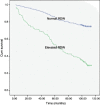Chronic Obstructive Pulmonary Disease and Its Effect on Red Blood Cell Indices
- PMID: 37065412
- PMCID: PMC10097512
- DOI: 10.7759/cureus.36100
Chronic Obstructive Pulmonary Disease and Its Effect on Red Blood Cell Indices
Abstract
Chronic obstructive pulmonary disease (COPD) constitutes a set of heterogeneous symptoms affecting millions of people worldwide. The associated comorbidities developing in COPD involve dysregulation in physiological pathways resulting from systemic inflammation in respiratory airways. In addition to mentioning the pathophysiology, stages, and consequences of COPD, this paper also defines red blood cell (RBC) indices such as hemoglobin, hematocrit, mean corpuscular volume, mean corpuscular hemoglobin concentration, red blood cell distribution width, and RBC count. It explains the role of RBC indices and RBC structural abnormalities with disease severity and exacerbations in COPD patients. Although many factors have been studied as a marker of morbidity and mortality for COPD patients, RBC indices have emerged as revolutionary evidence. Therefore, the effectiveness of evaluating RBC indices in COPD patients and their importance as a negative predictor of survival, mortality, and clinical outcomes have been debated through rigorous literature reviews. Furthermore, the prevalence, mechanisms of development, and prognosis of underlying anemia and polycythemia in COPD have also been evaluated, with anemia most significantly associated with COPD. Therefore, more studies should be conducted to address underlying anemia in COPD patients to lessen the severity and disease burden. Correcting the RBC indices in COPD patients remarkably impacts the quality of life and reduces in-patient admissions, healthcare resource utilization, and costs. Hence, it is noteworthy to understand the significance of considering RBC indices while dealing with COPD patients.
Keywords: anemia of chronic disease (acd); copd: chronic obstructive pulmonary disease; rbc indices; rbc structural alterations; secondary polycythemia.
Copyright © 2023, Tariq et al.
Conflict of interest statement
The authors have declared that no competing interests exist.
Figures


Similar articles
-
The Effects of Ramadan-Fasting (RF) on Inflammatory and Hematological Indices of Stable Chronic Obstructive Pulmonary Disease (COPD) Male Patients: A Pilot Study.Am J Mens Health. 2018 Nov;12(6):2089-2103. doi: 10.1177/1557988318794304. Epub 2018 Aug 17. Am J Mens Health. 2018. PMID: 30117367 Free PMC article.
-
Association between low mean corpuscular hemoglobin and prognosis in patients with exacerbation of chronic obstructive pulmonary disease.Respir Investig. 2021 Jul;59(4):498-504. doi: 10.1016/j.resinv.2021.01.006. Epub 2021 Feb 26. Respir Investig. 2021. PMID: 33642232
-
Anemia in Chronic obstructive pulmonary disease: Prevalence, pathogenesis, and potential impact.Lung India. 2015 Mar-Apr;32(2):142-51. doi: 10.4103/0970-2113.152626. Lung India. 2015. PMID: 25814799 Free PMC article. Review.
-
Association between RBC Indices, Anemia, and Obesity-Related Diseases Affected by Body Mass Index in Iranian Kurdish Population: Results from a Cohort Study in Western Iran.Int J Endocrinol. 2021 Sep 4;2021:9965728. doi: 10.1155/2021/9965728. eCollection 2021. Int J Endocrinol. 2021. PMID: 34527049 Free PMC article.
-
Proton pump inhibitors for chronic obstructive pulmonary disease.Cochrane Database Syst Rev. 2020 Aug 25;8(8):CD013113. doi: 10.1002/14651858.CD013113.pub2. Cochrane Database Syst Rev. 2020. PMID: 32844430 Free PMC article.
Cited by
-
Wound healing rates in COPD patients undergoing traditional pulmonary rehabilitation versus tailored Wound-Centric interventions.Int Wound J. 2024 Apr;21(4):e14863. doi: 10.1111/iwj.14863. Int Wound J. 2024. Retraction in: Int Wound J. 2025 Apr;22(4):e70663. doi: 10.1111/iwj.70663. PMID: 38606653 Free PMC article. Retracted. Clinical Trial.
-
Chronic Obstructive Pulmonary Disease and COVID-19: The Impact of Hematological Biomarkers on Disease Severity and Outcomes.J Clin Med. 2025 Apr 17;14(8):2765. doi: 10.3390/jcm14082765. J Clin Med. 2025. PMID: 40283596 Free PMC article. Review.
-
The Role of Trace Elements in COPD: Pathogenetic Mechanisms and Therapeutic Potential of Zinc, Iron, Magnesium, Selenium, Manganese, Copper, and Calcium.Nutrients. 2024 Nov 28;16(23):4118. doi: 10.3390/nu16234118. Nutrients. 2024. PMID: 39683514 Free PMC article. Review.
-
Analyzing the causal role of blood cells in aging: a Mendelian randomization study.Biogerontology. 2024 Nov 4;26(1):7. doi: 10.1007/s10522-024-10148-0. Biogerontology. 2024. PMID: 39495328
-
Prevalence and thrombotic risk of SGLT-2 inhibitor-associated erythrocytosis: a retrospective cohort study.Cardiovasc Diabetol. 2025 Jul 10;24(1):276. doi: 10.1186/s12933-025-02805-6. Cardiovasc Diabetol. 2025. PMID: 40640769 Free PMC article.
References
-
- Global, regional, and national deaths, prevalence, disability-adjusted life years, and years lived with disability for chronic obstructive pulmonary disease and asthma, 1990-2015: a systematic analysis for the Global Burden of Disease Study 2015. GBD 2015 Chronic Respiratory Disease Collaborators. Lancet Respir Med. 2017;5:691–706. - PMC - PubMed
-
- Global strategy for the diagnosis, management, and prevention of chronic obstructive pulmonary disease: GOLD executive summary. Vestbo J, Hurd SS, Agustí AG, et al. Am J Respir Crit Care Med. 2013;187:347–365. - PubMed
-
- COPD as a lung disease with systemic consequences--clinical impact, mechanisms, and potential for early intervention. Decramer M, Rennard S, Troosters T, et al. COPD. 2008;5:235–256. - PubMed
-
- Oxidative stress in COPD. Kirkham PA, Barnes PJ. Chest. 2013;144:266–273. - PubMed
-
- COPD: a multifactorial systemic disease. Huertas A, Palange P. Ther Adv Respir Dis. 2011;5:217–224. - PubMed
Publication types
LinkOut - more resources
Full Text Sources
